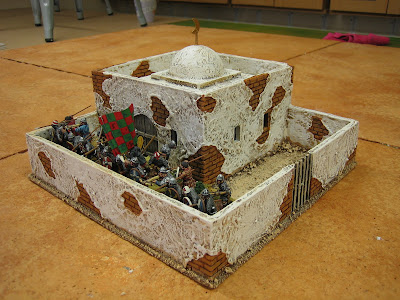Edit: When I linked this post on TMP, Col.Campbell (hi, Jim) commented on the name 'mangonel' being applied to this type of siege engine, thinking it should be called a 'trebuchet', specifically a 'traction trebuchet'. For some reason, I've always called them 'mangonels'. Luckily for all, both of us are right, and Jim posted this interesting link about the "Torsion Mangonel Myth" explaining why.
Before I get to the models, let's get the big issue out of the way. I know that throwing engines were not used in field battles. However, artillery, in any period, can be great table-top fun. I know because, I have a couple of onagers with Frankish crews (Gripping Beast Normans range, I think) which have seen the table a couple of times.
The basic design for these models is taken from various sources including pictures and models of Chinese mangonels. The scale I can only call 'table-top scale'; they were made to look just big enough to look like practical pieces of siege equipment.The model, with arm up, is 110mm tall overall.
The bases, like all the bases for my crusades stuff, is 4mm plywood. It seemed like a good idea at the time but, is now one I regret. Cutting 4mm ply with a Stanley knife is a hastle I can do without. The bases, for scale, are 60mm x 90mm.
They are made from recycled plastic.
The throwing arms are plastic pins (I can't remember their original use).
The green plastic beams are made from the plastic bases that come with plastic figures, glued together to make small pieces of plastic sheet. There are two thicknesses: three layers thick for the base frame; two layers thick for the upper structure.
The plastic is soft enough to be cut into 'planks' with a modelling knife. Each piece was sanded with fine sand paper after cutting to get rid of the burrs.
I added wood grain in two ways. At first I used the tip of a blade but, this was too slow. To speed things up a lot, I simply dragged the plastic over rough sand paper.
The throwing 'bag' is made from a piece of netted ribbon, and a few bits of wire drilled into place as axles and throwing hook finish the pieces.
Start to finish, they took about two hours to design (as I went along, more or less), and make.
There should probably be more ropes. However, as I can't find figures in poses suitable for actually pulling the ropes, I thought six would be sufficient to express the basic working principles of the thing.
The ropes are cotton button thread: a single thread has been wound around the beam; the actual ropes are two threads twisted and glued (PVA) together before being glued into place on top of the cotton around the beam.
The best crew I've found so far are Gripping Beast shepherds. Each model will get a crew of four figures idly standing about the place. The figure with the staff / crook over his shoulder will be given a longer pole with a hook on the end - he's the guy who hooks the throwing bag after firing to drag the arm back down into the launching position.
Neat little models that cost next to nothing. Something from scrap.
Neat little models that cost next to nothing. Something from scrap.










